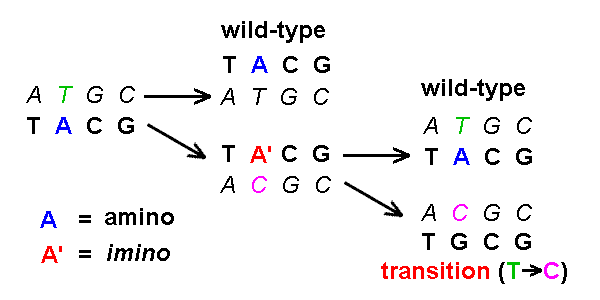
Induction of transition mutations by
spontaneous tautomeric shifts
In the original
double-stranded DNA molecule, A
in the standard (amino) form pairs with T.
During replication, the two strands separate. In the upper
diagram, T pairs with A as usual, which replicates the
wild-type sequence. In the lower diagram, A has undergone a tautomeric
shift to the non-standard (imino) form A', which pairs with C. In the next round of
replication, the imino A'
shifts back to the amino A form,
which
pairs with T, which again
reproduces the wild-type sequence. Replication of the other strand
pairs C with G. By
comparison with the original molecule, the result is a
T C mutation. A
tautomeric shift in one strand has produced a
transition mutation in the complementary strand. If
the mutation occurs in the germline, it will be transmitted to
future generations.
C mutation. A
tautomeric shift in one strand has produced a
transition mutation in the complementary strand. If
the mutation occurs in the germline, it will be transmitted to
future generations.
IMPORTANT: a tautomeric shift is not
a mutation, but a transient proton
shift to an alternative form of a base, which results in a
mutation.
HOMEWORK:
Based on this diagram, demonstrate that the tautomeric shifts of
the other three bases also produce transition mutations.

